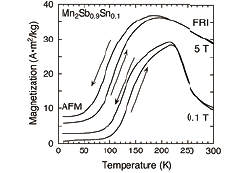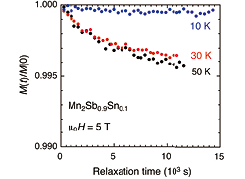First-order Magnetic Transitions and Transformation Arrested Behaviors in Sn-Modified Mn2Sb
Y. Mitsui, K. Koyama, and Y. Uwatoko
First-order magnetic transition (FOMT) has been paid much attention such as the large magnetocaloric effects and metamagnetic shape memory effects. FOMT in some magnetic functional materials suppressed under high magnetic fields. The suppression of FOMT is due to the freezing of the phase transition, which is explained by glass-like dynamics. This phenomenon is called "kinetic arrest" or "thermal transformation arrest (TTA)". For the application of magnetic functional materials using FOMT, the investigation of the origin of TTA phenomenon is necessary.

Fig. 1. Thermomagnetization curves for Mn2Sb0.9Sn0.1 under 0.1 and 5 T [4].

Fig. 2. Magnetic relaxation curves for Mn2Sb0.9Sn0.1 at 10, 30, and 50 K in 5 T [4]. The magnetization M(t) was normalized by M(0).
Mn2Sb-based compounds exhibit FOMT between ferrimagnetic (FRI) and antiferromagnetic (AFM) state. So far, magnetocaloric effects for Mn2Sb-based system were examined [1]. Although Mn2Sb is ferrimagnet and do not show FOMT, FRI-AFM transition exhibits by substitution of V, Cr, Co and Cu to Mn-site. Additionally, it is reported that Co-, and Cu-modified Mn2Sb exhibited TTA phenomenon [2, 3]. Meanwhile, modification of Sb-site, such as Mn2Sb1-xGex [3] and Mn2Sb1-xSnx, also exhibits FRI-AFM transition. However, there are few reports about TTA phenomenon for these compounds. In this paper, we reported the thermal transformation arrest behavior of Sn-modified Mn2Sb by magnetization measurements [4].
Figure 1 shows the thermomagnetization (M-T) curves in Mn2Sb0.9Sn0.1 under μ0H = 0.1 and 5 T. FRI-AFM phase transition were observed for 100 ≤ T ≤ 210 K at μ0H = 0.1 T. It is found that the temperature region of FOMT in Mn2Sb0.9Sn0.1 is wider than other Mn2Sb-based systems, such as Mn1.8Co0.2Sb [2] and Mn2Sb0.9Ge0.1 [3]. On the other hand, the difference in M between heating process after zero-field cooling and in-field cooling were observed for T < 50 K in 5 T. It is suggested that the FRI-AFM transition were suppressed and residual FRI state existed. In other words, FRI state was arrested at in-field cooling process under 5 T.
For further investigation for the difference of magnetization, magnetic relaxation measurements were carried out. Figure 2 shows the magnetic relaxation curves at 10, 30 and 50 K under 5 T. The measurements were performed after in-field cooling under 5 T. Although the fraction of arrested FRI state was small, magnetization clearly decreased both 30 and 50 K with increasing time, indicating the relaxation from arrested-FRI state to AFM state.
In conclusion, magnetic properties of Sn-modified Mn2Sb were investigated. It is suggested by magnetic relaxation measurements that TTA phenomenon exhibits in Mn2Sb0.9Sn0.1.
References
- [1] L. Caron et al., Appl. Phys. Lett. 103, 112404 (2013).
- [2] H. Orihashi et al., Mater. Trans. 54, 969 (2013).
- [3] Y. Matsumoto et al., IEEE Trans. Magn. 50, 1000704 (2014).
- [4] T. Wakamori et al., AIP Conf. Proc. 1763, 020006 (2016).
- [5] T. Wakamori et al., IEEE Magn. Lett. 8, 1402404 (2017).
